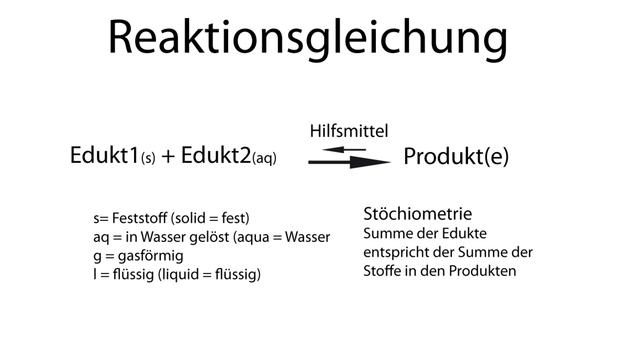VIDEO: How do you set up reaction equations?
In order to correctly describe chemical reactions using reaction equations, you not only need the products and starting materials you should also know what the reaction is and what stoichiometry it is to calculate. With the right information and a little practice, this is not a problem.
This is how you set up reaction equations
- First write the starting materials on the left or the starting materials for your reaction to.
- Ideally, you should also state how the starting materials are available. If a starting material is a solid, write a small s next to the element symbol at the bottom left. An aq represents the symbol when a substance is dissolved in water. With g you mark gaseous starting materials and with an l you mark liquid starting materials.
- Now you need to draw the reaction arrows for the reactions in the reaction equations. A normal arrow is used for a normal response. If there is a back and forth reaction, write an arrow to the right and an arrow of the same size to the left underneath. If one of the two reactions predominates, this is shown with arrows of different sizes. If, on the other hand, it is an equilibrium reaction, only the upper line is drawn in the upper arrow and only the lower line of the arrowhead is drawn in the lower arrow.
- Are additional things required for the reaction, such as solvents, catalysts or energy, so these things are written above the reaction arrow.
- Now all you have to do is write down all the resulting products on the right-hand side of the reaction equation.
- Now all you have to do is determine the stoichiometry of the reaction equations.
Chemical equations for beginners - exercises
To understand nature, you have to be able to describe it. Chemical processes are ...
This is how you determine the stoichiometry of the reaction equation

- The stoichiometry of the reaction equation is an important point. So first check whether the empirical formula of the products and starting materials is correct.
- If so, count the number of individual items on each page. If the number already matches, you do not need to do anything else.
- If a number does not match, you must increase the number of starting materials and products so that the stoichiometry is correct.
- Example: Ammonia is to be produced from nitrogen and hydrogen. N2 (g) + H2 (g) → NH3. There are two nitrogen atoms on the left, but only one nitrogen atom on the right. Thus you expand the product page with 2. N2 (g) + H2 (g) → 2 NH3. There are now 6 hydrogen atoms on the right-hand side. So if you now increase the hydrogen number on the educt side by 3, you get the correct stoichiometry: N2 (g) + 3 H.2(g) → 2 NH3.




